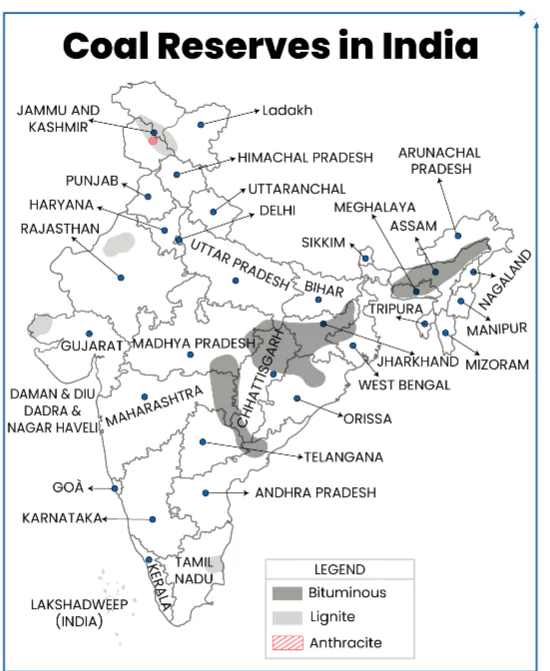Rajasthan Rajya Vidyut Utpadan Nigam Limited (RRVUNL) has once again questioned the legitimacy of a report by the Chhattisgarh State Scheduled Tribes Commission (CSSTC), which found irregularities in environmental clearances for the Parsa coal mine in the Surguja region of Chhattisgarh.
Key Highlights of the Report
- Alleged Irregularities in Environmental Clearances: The CSSTC found irregularities in obtaining environmental clearances for the Parsa coal mine project.
- Forgery Claims: The Commission alleged that forged documents were used, particularly concerning the consent of the gram sabha (village council).
- Recommendations: The CSSTC recommended the cancellation of forest clearances for the project, citing biodiversity concerns in the Surguja region.
Enroll now for UPSC Online Course
About Coal and types of Coal
- Coal is a readily combustible, black or brownish-black sedimentary rock predominantly made of carbon.
- This is a solid fossil fuel formed over millions of years from the remains of plants.
- As these plants decompose under high pressure and heat, they transform into various types of coal, ranging from low-grade lignite to high-grade anthracite.
- Types of coal in India:
| Types of Coal |
Characteristics |
Found In |
| Anthracite |
- Highest grade of coal with 80-95% carbon content
- Hard, brittle, black, and lustrous.
|
Jammu and Kashmir |
| Bituminous |
- Medium-grade coal with high heating capacity
- Most commonly used for electricity generation
|
Jharkhand, Odisha, West Bengal, Chhattisgarh, Madhya Pradesh |
| Subbituminous |
- Black, dull (not shiny), with a higher heating value than lignite
|
Jharkhand, Odisha, Chhattisgarh, parts of other Gondwana fields |
| Lignite |
- Lowest grade of coal with low carbon content
- Brownish-black, used primarily for power generation.
|
Rajasthan, Tamil Nadu, Jammu & Kashmir |
Distribution of Coal in India

- Gondwana Coal Fields (250 million years old): It accounts for 98% of India’s coal reserves and 99% of its production. The coal of the region is of superior quality, high ash content, including metallurgical grade coal.
- It is Found in following locations:
- Damodar Valley (Jharkhand, West Bengal)
- Mahanadi Valley (Chhattisgarh, Odisha)
- Godavari Valley (Maharashtra)
- Narmada Valley
- Tertiary Coal Fields (15–60 million years old): Carbon content is low, rich in moisture and sulfur.
- It is found in Following Locations
- Extra-peninsular regions (Assam, Meghalaya, Nagaland, Arunachal Pradesh, J&K)
- Himalayan foothills (Darjeeling, West Bengal)
- Rajasthan, Uttar Pradesh, Kerala
Key Data on Coal in India
- 5th Largest Geological Reserves: India holds the 5th largest coal reserves in the world.
- 2nd Largest Consumer: India is the 2nd largest consumer of coal globally.
- 2nd Largest Importer: India is also the 2nd largest importer of coal.
- Power Generation: Coal and lignite support 50.7% of India’s power generation (as of 2023).
- Top Coal Reserve States:
- Odisha: Largest coal reserves in India.
- Together, Odisha, Jharkhand, and Chhattisgarh account for 69% of India’s total coal resources.
- Chhattisgarh-based Coal India subsidiary South Eastern Coalfields Limited (SECL) Gevra and Kusmunda coal mines have secured the 2nd and 4th spot in the list of the world’s 10 largest coal mines released by WorldAtlas.com.
|
Check Out UPSC CSE Books From PW Store
Role of Coal in India’s Energy Sector
- Dominant Fuel Source: Coal is the primary fuel source for India’s power generation, accounting for a substantial portion of the country’s energy mix. It is used in more than 70% of the total power generation.
- Coal-based power generation in India has played a significant role in meeting the country’s energy demands.
- India is currently experiencing a substantial increase in power demand, driven by a combination of factors like industrial growth, technological advancements, population growth, economic development etc.
- Industrial Backbone: Coal is essential for various industries, including steel, cement, and fertilizers.
- Economic Growth: Coal-based industries contribute significantly to India’s economic growth and employment.
- Challenges and Transition: India is gradually transitioning towards cleaner energy sources to reduce its reliance on coal. However, coal remains a vital part of the country’s energy landscape.
![]() 19 Nov 2024
19 Nov 2024


